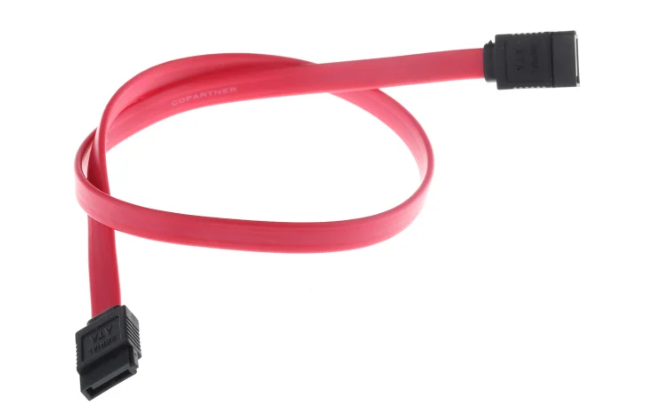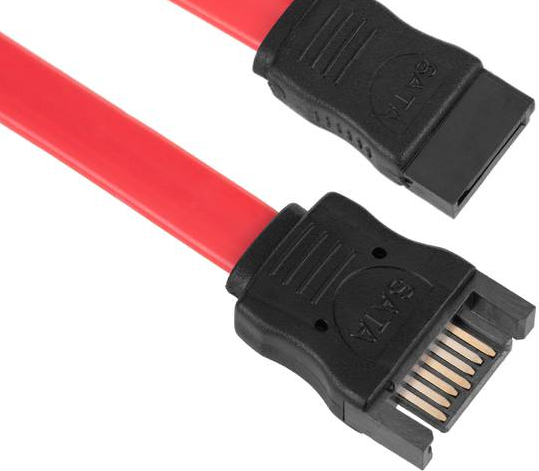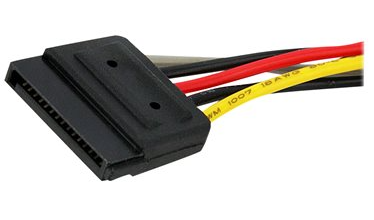PAGE CONTENT:
- 1. What is SATA & SATA Cable
- 2. Different Types of SATA Cable
- 3. How to Use SATA Cable
- 4. Differences Between SATA vs. PATA
What is SATA & SATA Cable
SATA, the Serial Advanced Technology Attachment abbreviation, is one computer bus interface that connects your computer host to other storage devices like hard disk drives, optical drives, and SATA hard drives. It is the most popular storage interface today and is used for most consumer-grade hard drives. SATA was developed and introduced by Intel in 2003, and it has become the standard for connecting an HDD to a desktop or laptop computer since that time.
SATA cable is a special wire that helps connect the host bus adapter, such as a motherboard and massive storage device. It supports hot plugging, meaning the OS can recognize the device without restarting full device.

(image source:https://hkcn.rs-online.com/web/p/sata-cables/7581553)
Different Types of SATA Cable
So far, SATA cable has experienced three generations, including SATA-1, SATA-2, and SATA-3. Essentially, they make no difference but vary for the transferring speed and some specifications. Look at the chart to explore more details.
| SATA-1 | SATA-2 | SATA-3 | |
| Released Date | January 2003 | April 2004 | July 2008 |
| Transfer Rate | 1.5 Gbit/s | 3 Gbit/s | 6 Gbit/s |
| Bandwidth Throughput | 150 MB/s | 300 MB/s | 600 MB/s |
| Interface | Serial ATA-150 | Serial ATA-300 | Serial ATA-600 |
There are various types of SATA cables out there, but they can be divided into two main kinds: SATA data cable and SATA power cable.
As the name suggests, the data cable is used to transfer data. The connector of this cable has 7-pins. You need to connect one end to the PC’s SATA interface and the other end to the hard drive. The cable usually adopts a flat line to ensure fast transferring speed.

(image source: https://media.cablematic.com/)
SATA power cables are larger than data cables because they are equipped with a 15-pin interface. It is mainly designed to supply power for those storage devices and optical drives which need power.
Usually, a SATA power adapter can have 1-4 connectors to provide power for different devices, which can work simultaneously.

(image source: https://cdn.cnetcontent.com/)
Apart from those two types, some other SATA connectors are also available, like e-SATA, micro SATA, SATA to USB, low profile SATA, etc. If you'd like to know more types of SATA types, read this wiki page, it will introduce those SATA types from all aspects, and also those basic concepts about SATA.
How to Use SATA Cable
Using a SATA adapter is very easy if you have a clear operational purpose. Just prepare a correct adapter, and make sure each connector is connected to the corresponding end.
Here is a step-by-step guide on connecting SATA drives to a PC with a USB to SATA adapter.
Step 1. Power your SATA drive by connecting its power cable to the power supply.
Step 2. Check the drive to ensure it is operable.
Step 3. Connect the SATA drive to the USB to SATA adapter.
Step 4. Finally, connect your USB to SATA adapter to your PC.
Differences Between SATA vs. PATA
SATA is the advanced and improved version of PATA, which has almost replaced PATA nowadays for any transferring use. So, what are the differences between them?
Compared with PATA, SATA has a smaller size, lower cost, higher signal rate, and faster transfer speed.
First, PATA features a larger size and at least a 40-pin connector, while SATA only has a 7-pin or 15-pin, which helps save space and is easy to carry. What's more, SATA is much more cost-saving and less power-consuming compared with PATA.
Another distinctive feature is transferring speed. Because PATA supports multitasking in parallel, making it slower than SATA. After continuous technical improvement, SATA helps to achieve faster, more stable, and larger-size data.
Conclusion
In conclusion, the article introduces SATA in four different aspects, which allows you to understand the SATA cable thoroughly. SATA adapter plays an important role in connecting PC and other storage devices. Its prolific types satisfy various needs of transferring data and supplying power.
Was This Page Helpful?
Oliver is an EaseUS professional writer who dares explore new areas. With a passion for solving tech issues with straightforward guides for common users, Oliver keeps honing his writing craft by developing in-depth solutions for disk and partition management, computer boot-up issues, file transfer, etc.
Written by Larissa
Larissa has rich experience in writing technical articles and is now a professional editor at EaseUS. She is good at writing articles about data recovery, disk cloning, disk partitioning, data backup, and other related knowledge. Her detailed and ultimate guides help users find effective solutions to their problems. She is fond of traveling, reading, and riding in her spare time.
Related Articles
-
Command R Mac | Use Command R to Reinstall macOS
 Brithny/2025-06-30
Brithny/2025-06-30 -
WD Elements vs. My Passport, Everything You Should Know
 Cici/2025-07-04
Cici/2025-07-04 -
What is AMD CPU fTPM? Everything You Need to Know
 Daisy/2025-07-04
Daisy/2025-07-04 -
How to Kill All the Processes in Windows 10/11
 Daisy/2025-06-30
Daisy/2025-06-30